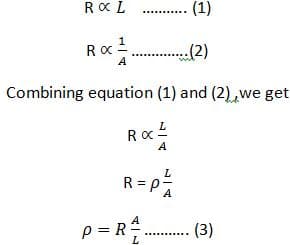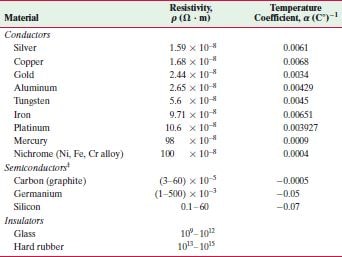
The basic difference between resistance and resistivity is that resistance is the opposition to the flow of current in the conductor while resistivity is the resistance of the meter cube of a wire or conductor. The SI unit of resistance is ohm while the SI unit of resistivity is ( ohmmeter ).
Comparison table: Resistance Vs Resistivity
| Resistance | Resistivity |
| It is the opposition to the flow of electric current through a conductor. | It is the resistance of a meter cube of a wire. |
| Its SI unit is ohm ( Ω ). | Its SI unit is ohm-meter (Ω-m). |
| It depends upon the length and area of the cross-section of the wire. | It does not depend upon the length and area of the cross-section of the wire. |
Now!
We learn in detail about resistance and resistivity.
What is Resistance?
From the relation of Ohm’s law (V=IR), R is the constant of proportionality and is called the resistance of the conductor. It is defined as: “The opposition to the flow of charge through a conductor is called electrical resistance.
The SI unit of resistance is ohm (Ω ). It is defined as “Resistance is said to be 1 ohm, when one ampere of current passes through the conductor due to the potential difference of one volt across its ends.”It can be expressed as:
R = V/I
Therefore
1 ohm =1 volt/1 ampere
The resistance of a conductor depends upon
- Dimensions of the conductor ( length and area of the cross-section).
- The physical state of the conductor (temperature etc ).
See also: Factors affecting resistance
What is resistivity?
Resistivity can be defined as the resistance of a meter cube of a wire. It is the property of the material of which the wire is made.
It has been observed experimentally that the resistance R of a wire is directly proportional to its length L and inversely proportional to its area of cross-section of the wire. i.e.

If L= 1m and A= 1m² ,then above equation (3) becomes ρ = R.
So resistivity is defined as: ” the resistance of wire whose length is one meter and whose area of cross-section is one-meter square.
SI unit of resistivity is ohm-meter (Ωm). It depends upon the nature of the material and temperature of the material, it is independent of the dimensions of the conductor.
The resistivity of some materials is given in the table:

See also: Types of resistors
Effect of temperature on resistance
The resistance and resistivity of a substance depend upon the temperature. As the temperature of the conductor rises, the amplitude of vibration of the atoms in the lattice increases. So, the collision cross-section of the atoms increases.
Thus the atoms then offer a bigger target. This increases the probability of their collision with free electrons. Hence, the resistance of the conductor increases.
Experimentally, it is found that changes in resistivity of a metallic conductor with the temperature are linear over a considerable range below and above 0 Cº. This shows that resistivity is not zero at 0 Cº.
See also: Difference between conductors and insulators
Temperature coefficient of resistance
The fractional change in resistance of a substance per kelvin is called the temperature coefficient of resistance.
Mathematically it is expressed as:

Where
R0= Resistance of material at 0 Cº.
Rt = Resistance of material at t Cº.
t = Change in temperature
α = temperature coefficient of resistance.
Temperature coefficient of resistivity
The fractional change in resistivity of material per kelvin is called the temperature coefficient of resistivity. Mathematically it is expressed as:

ρ0= Resistivity of material at 0 Cº.
ρt = Resistivity of material at t Cº.
t = Change in temperature
α = temperature coefficient of Resistivity.
SI unit of the temperature coefficient of resistance /resistivity is per kelvin.
Conclusion: Key differences between resistance and resistivity
- Resistance is the property of the material that obstructs current flow, while resistivity gives the resistance of the material that has a fixed dimension.
- Resistance is the ratio of the length and cross-sectional area of the conductor, while the resistivity of the material is the ratio of the product of the resistance and the area to the length of the conductor.
- Resistance is represented by the symbol R, while resistivity is represented by the symbol ρ.
- The SI unit of resistance is the ohm and the SI unit of resistivity is the ohm-meter.
- The resistance of the material depends on the length, the cross-section, and the area of the conductor, while the resistivity depends on the nature and temperature of the material.
For related Topics visit our page: Electricity and magnetism
For more information:
- Difference between current and voltage
- Ohm’s law formula
- Types of charges
- Coulomb’s law formula
- Gauss’s law
- Difference between conductors and insulators
External reference: https://byjus.com/physics/difference-between-resistance-and-resistivity/
One Comment